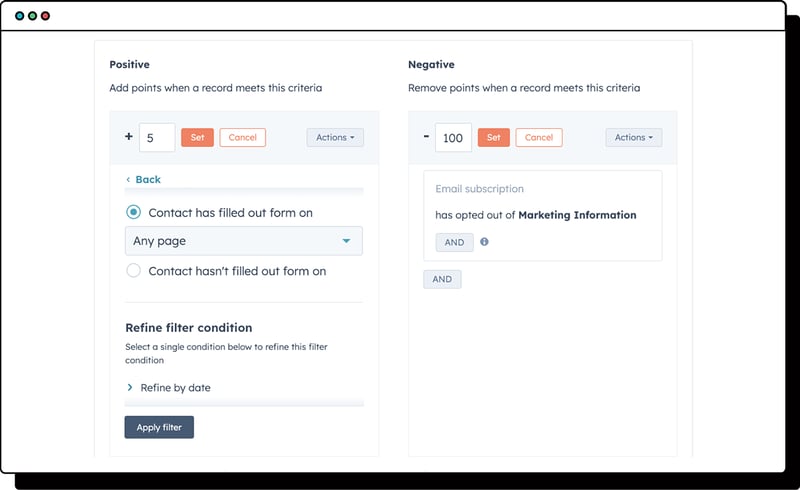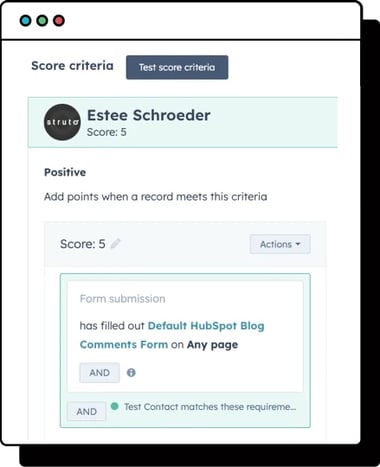In today's fast-paced digital landscape, generating leads is a top priority for businesses. However, not all leads are created equal, and identifying the most promising prospects can be a tricky task. This is where HubSpot Lead Scoring comes into play.
HubSpot offers a powerful lead-scoring feature that enables businesses to prioritise and focus their efforts on the most valuable leads. Let’s look at how this feature works and how your business can benefit from it.
Understanding HubSpot lead scoring
HubSpot Lead Scoring is a data-driven method that assigns a numerical value to each lead based on its perceived likelihood to become a customer. The scoring method considers various factors such as lead engagement, demographic information, and behaviour patterns shown on your website or within your marketing campaigns.

The process starts by defining specific criteria and assigning a value to them based on their importance to your business. These criteria can include factors like job title, industry, website activity, email opens, form submissions, and more. Each set of criteria is assigned a positive or negative score, indicating its impact on lead qualification.
Once the criteria and their corresponding values are established, HubSpot's lead scoring algorithm automatically calculates a cumulative score for each lead. The higher the score, the more qualified and valuable the lead is deemed to be. This helps your marketing and sales teams prioritise their efforts, focusing on leads that are more likely to convert into customers.
How would lead scoring look in your CRM?
Your HubSpot lead scoring is set on the Contact object property called HubSpot Score.

Within this property is where you will build your score by using filters to add score criteria. Each set of criteria can contain multiple filters of positive or negative actions. Points are added or removed when a record meets all the criteria in a set.
In the following example, if a contact fills out a form on any page, they are scored with 5 positive points, however if the contact opts out of marketing information, they would have a negative score of 100 associated with their lead score.

To add additional criteria in the existing set, click AND. Records will need to meet all criteria in this set for the score to apply.

Click ‘+Add Criteria’ to add your next separate set of criteria that lead to a certain score.

Carry on creating your lead scoring criteria until you have added all the actions to meet the criteria of your Ideal Customer Profile.
Once you are happy with your lead scoring criteria it is recommended that you test a contact. Simply click ‘Test score criteria’ and choose a contact record.

Setting your automation
Once you have your lead scoring criteria defined it’s time to think about how your scoring would be used in automation.
The example workflow below sets the lifecycle stage of any contacts with a HubSpot score of greater than or equal to 200 to Marketing Qualified Lead.

It is a good idea to define any automation and follow-up actions within your lead scoring planning and collaboration meetings.
Best practices for HubSpot lead scoring
Let’s discuss the best practices of lead scoring. Whether you are still starting out or you are a seasoned HubSpot user, these best practices will give you valuable insights and help optimise your lead-scoring logic.

1. Define your ideal customer profile:
Before setting up lead scoring in HubSpot, it's essential to have a clear understanding of your ideal customer. Analyse your existing customer base and identify key characteristics such as industry, company size, job title, and behavioral patterns. This information will guide you in creating meaningful lead-scoring criteria.
2. Collaborate between marketing and sales:
To develop an effective lead scoring system, close collaboration between your marketing and sales teams is crucial. Both teams should align on the criteria and weights assigned to each factor. Regular feedback and communication will ensure the lead scoring model remains relevant and optimised over time.
3. Start with basic criteria
When implementing lead scoring for the first time, it's advisable to start with a set of basic criteria that can be easily tracked and measured. These can include email opens, website visits, and content downloads. As you gain more experience and data, you can refine and expand your lead scoring criteria.
4. Continuously monitor and refine
Lead scoring is not a set-it-and-forget-it process. Regularly review and analyse the performance of your lead scoring model. Identify trends, adjust criteria values, and add or remove factors based on their effectiveness. This iterative approach ensures your lead scoring system remains accurate and aligned with your business objectives.
5. Utilise lifecycle stages
HubSpot offers lifecycle stages, such as subscriber, lead, marketing qualified lead (MQL), sales qualified lead (SQL), and customer. By incorporating these stages into your lead scoring model, you can better track and manage leads throughout the customer journey. Adjust scores as leads progress through each stage, reflecting their changing level of engagement and intent.
6. Time-based factors
Assign higher scores to recent activities, as they indicate a higher level of interest. This could be a response to a marketing email or a submission on a particular form. Additionally, consider how long a lead has been in your database without showing any engagement. Leads that have gone cold may require re-engagement strategies.Conclusion

HubSpot lead scoring empowers businesses to identify and prioritise high-quality leads, enabling them to nurture their contacts timeously, based on perceived interest. Consider lead scoring to ensure you nurture your leads accordingly and increase your conversion rate.
